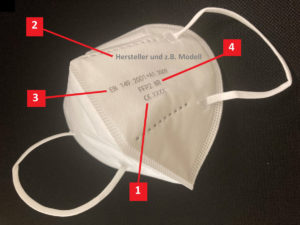[et_pb_post_title title="off" meta="off" featured_image="off" admin_label="New regulations on the use of respiratory protection in shops and in local passenger traffic
" _builder_version="4.6.6″ z_index_tablet="500″][et_pb_text admin_label="New specifications for the use of respiratory protection in shops and in local passenger traffic
" _builder_version="4.8.1″ module_alignment="left" custom_padding="||0px||" hover_enabled="0″ z_index_tablet="500″ box_shadow_horizontal_tablet="0px" box_shadow_vertical_tablet="0px" box_shadow_blur_tablet="40px" box_shadow_spread_tablet="0px" sticky_enabled="0″]
New regulations on the use of respiratory protection in shops and in local passenger traffic
As many with a relevant professional background have known for a long time, the everyday masks or scarves approved to date do not provide any real protection against infection for the wearers or their environment.
Due to the continuing high number of cases of new infections, very high death rates and the particularly infectious corona mutations, the Corona Summit on 20.01.2021 not only tightened up the existing mask requirement and extended the lockdown, but also made it more stringent in the long term.
Since 25.01.2021, the wearing of medical masks in the form of OP masks, FFP2 or KN95/ CPA masks has been mandatory in local public transport (ÖPNV) and in shops that are still open. The use of everyday masks or scarves is no longer permitted here. The masks now required provide a defined and significantly higher level of protection against infection for the wearer (limited in the case of the surgical mask) as well as for the environment, if they are used properly.
In order to ensure adequate protection, it is necessary for the masks to fit tightly on the face; some beard shapes or even deeper scars in the course of the rim prevent proper filtration of the inhaled air. The FFP 2 mask with exhalation valve, which is commonly used in occupational safety, e.g. at contaminated sites or in the presence of dust, and which reduces moisture penetration of the mask body by condensing humidity in the exhaled air, does not guarantee the desired protection of the environment.
Certified FFP2 masks have the following markings on the masks and their smallest commercial packaging unit:

- (1) CE marking with the NB number (four-digit Arabic numerical sequence, monitoring body of the product).
- (2) The name, trademark or other means of identifying the manufacturer and a product designation identifying the FFP mask.
- (3) Specification of the applied standard EN 149:2001+A1:2009 or English version EN 149:2009-08
- (4) Indication of the device class, e.g. FFP2 and FFP3
- (4) Period of use of the half mask: "NR" = use is limited to one shift, "R" = mask is reusable, "D" for dust test with dolomite (not relevant for protection against corona).
Masks with the designation KN95 (Chinese designation) are temporarily equivalent to the FFP 2 masks as pandemic respirators if they are classified in a simplified procedure as CPA masks (Corona SARS CoV-2 Pandemie Amasks) are recognised.
For the use of surgical masks, there are no occupational health and safety regulations on wearing time limits, as there are no significant additional stresses on the respiratory tract when using these masks. However, in their original form of use, these masks were primarily designed to protect the environment from pathogens, not to protect the wearer.
No inhalation resistance evaluations are currently available for the KN95 masks, as these masks are not listed on the European market as personal protective equipment in the sense of the PPE User Regulation and have therefore not been tested accordingly.
For the certified FFP2 masks which are assigned to CE category III as personal protective equipment against irreversible or fatal damage to health in the sense of the PPE user ordinance and are correspondingly tested by certified test centres, the following are specified in DGUV regulation 112-190 "Respiratory protective devices". Carrying time limits set for use at work.
Against the background of a slightly increased inhalation resistance (up to 5 mbar - equipment group 1) when using FFP2 masks without an exhalation valve as personal protective equipment in the area of work-related health hazards, the following is recommended for the use of FFP2 masks Offer of occupational health screening according to the principle G 26.1 "Breathing apparatus", a Training or instruction in the appropriate use of the breathing apparatus and the Compliance with wearing time limits of 75 minutes for moderately heavy work (A2: breathing volume > 20 - 40 l/minute). For light work with a breathing volume of less than 20 l/minute, according to the rules, operating times of around 110 minutes (just under 2 hours) are permissible. When using public transport, it can be assumed that a breathing volume of 20 l/minute is not exceeded; the same applies to normal shopping. With a Operational use are maximum 5 inserts Under FFP2 mask with 30-minute recovery breaks afterwards. Permissible per work shift.
#mullandpartner #engineeringforabettertomorrow #news
Our business areas
Environmental and geotechnical engineering
Construction and project management
Renewable energies
Real estate development
Infrastructure
Water management
Our companies
M&P Engineering Company
M&P Engineering Company Munich
T&P Beratende Ingenieure
P&P Real Estate Consulting
P&B Real Estate Management
P&M Project Management
M&P Umwelttechnik
Please contact us
Follow us on

